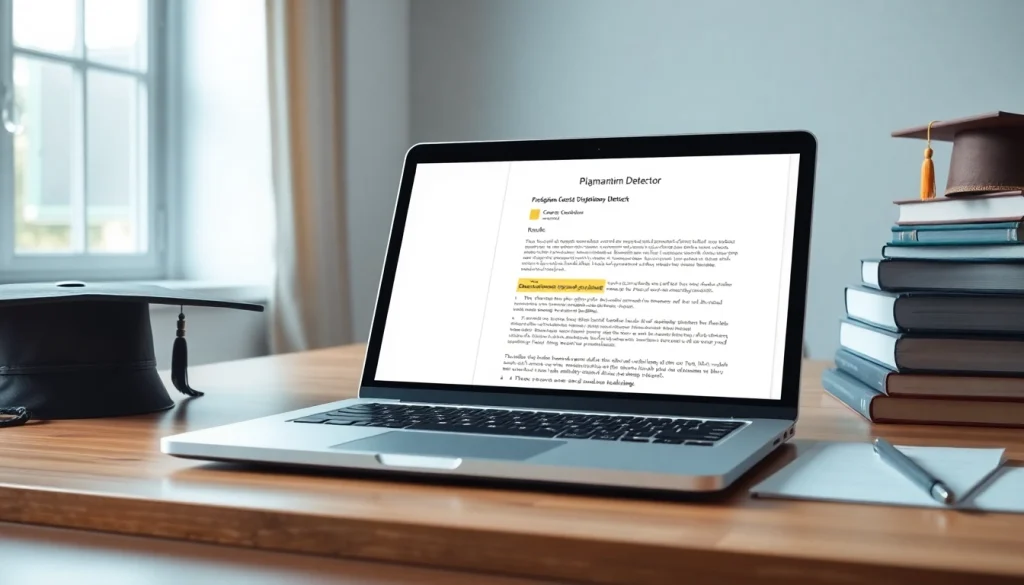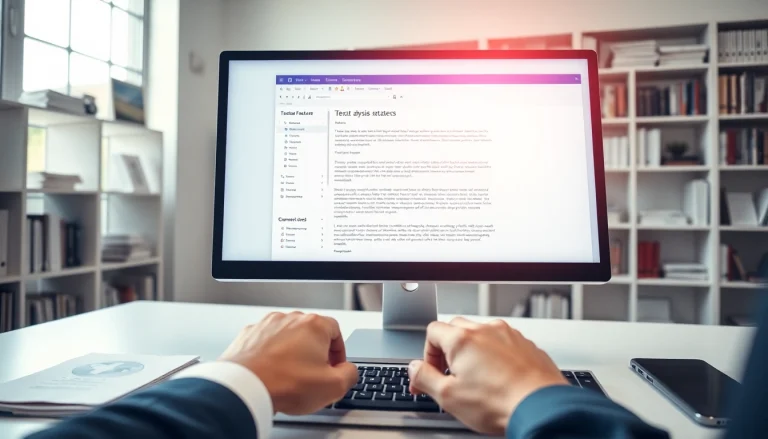
Understanding Plagiarism Detectors
What is a Plagiarism Detector?
A plagiarism detector is a software tool designed to identify instances of plagiarism in written documents. The primary goal is to ascertain the originality of a text by comparing it against a vast database of sources, including academic papers, articles, and content available on the internet. Plagiarism detection technology plays a crucial role in maintaining academic and professional integrity, providing writers, educators, and publishers with a means to ensure that the content they produce is unique and properly attributed.
How Plagiarism Detectors Work
Plagiarism detectors utilize sophisticated algorithms and databases to identify similarities between the submitted text and existing content. The process generally involves the following steps:
- Text Processing: The software scans the text to evaluate its structure and syntax, breaking it down into manageable segments for analysis.
- Database Comparison: The detector compares the processed text against a vast array of sources stored in its database, which could include books, articles, academic journals, and online content.
- Similarity Calculation: After comparing, the tool computes a similarity score, outlining how much of the text overlaps with existing material.
- Report Generation: Once the analysis is complete, a report is generated, highlighting specific passages that may be considered plagiarized and providing links to the original sources.
Types of Plagiarism Detection Software
There are various types of plagiarism detection software available, each catering to different needs. These include:
- Web-based Tools: Accessible via the internet, these tools require no installation and offer quick checks for users. Examples include plagiarism detector tools that allow for instant results.
- Desktop Software: These applications are installed on computers and may offer more robust features and databases, suitable for institutions and professionals.
- Educational Platforms: Some online learning management systems (LMS) incorporate plagiarism detection as a part of their services, aiding both students and educators in maintaining academic integrity.
- Real-time Checkers: These tools check text for plagiarism as it is being created, providing suggestions for original phrasing and citations.
Benefits of Using a Plagiarism Detector
Ensuring Academic Integrity
One of the primary benefits of using a plagiarism detector lies in its ability to uphold academic integrity. Educational institutions place a strong emphasis on originality and proper citation practices. By utilizing plagiarism detection software, students and researchers can ensure that their work adheres to these standards, thus avoiding the consequences of academic dishonesty, which can range from failing grades to expulsion.
Enhancing Content Originality
In an era where content is abundant, originality is key. Writers, bloggers, and marketers can benefit significantly from plagiarism detectors by using these tools to steer their creativity. Instead of unintentionally borrowing excessively from existing sources, writers can receive insights on how to better express their ideas, ensuring that their work stands out in a saturated marketplace.
Supporting Professional Writing
Plagiarism detectors are not just for students; professionals in various fields, including journalism, publishing, and content creation, use these tools to maintain the quality and integrity of their work. Using a plagiarism detector helps professionals verify their content’s originality before publishing, which can protect their reputation and credibility in their respective industries.
Choosing the Right Plagiarism Detector
Features to Look For
Choosing the right plagiarism detection tool involves evaluating various features to ensure it meets your needs. Some key features to consider include:
- Database Size: A larger database increases the chances of detecting matches, making it essential to choose a detector with a comprehensive and updated database.
- Detection Algorithms: Advanced algorithms improve accuracy and reduce false positives, ensuring that the results are reliable.
- Reporting Features: Detailed reports should outline sources of plagiarism, similarity percentages, and options for paraphrasing to aid users in improving their content.
- User Interface: A user-friendly interface enhances the experience, allowing users to navigate through the tool without frustration.
Free vs. Paid Options
Plagiarism detection tools can be divided into free and paid options. Free tools often have limitations such as restricted database access and fewer features. However, they can be beneficial for casual writers or students. On the other hand, paid options usually offer advanced features, including access to larger databases, detailed reports, and better customer support. Organizations and heavy users will generally find value in investing in a paid plan to leverage comprehensive functionality and reliability.
User Reviews and Comparisons
Before selecting a plagiarism detector, it is wise to read user reviews and compare various tools. Websites like G2, Capterra, and Trustpilot provide valuable insights into users’ experiences and highlight the strengths and weaknesses of different software. This research can help make informed decisions and select a tool that aligns well with your requirements.
How to Effectively Use a Plagiarism Detector
Step-by-Step Guide for Users
Using a plagiarism detector efficiently can maximize its benefits. Here is a step-by-step guide:
- Choose the Right Tool: Based on your needs and preferences, select a plagiarism detector that suits your requirements.
- Submit Your Text: Copy and paste or upload your document into the software.
- Run the Check: Initiate the plagiarism detection process and wait for the results, which may take anywhere from a few seconds to several minutes.
- Review the Report: Carefully examine the report generated, focusing on flagged content and potential sources of plagiarism.
- Make Necessary Edits: Utilize the insights from the report to modify, paraphrase, or properly cite any plagiarized content.
- Recheck If Necessary: If substantial edits are made, consider running a second check to ensure the text is now original.
Common Mistakes to Avoid
When using plagiarism detectors, certain pitfalls can lead to inadequate results:
- Ignoring the Results: Failing to review the provided report or discarding warnings can perpetuate plagiarism issues.
- Over-reliance on Software: While detectors are useful, they should not replace critical thinking and writing skills.
- Neglecting Proper Citations: Users often overlook the necessity of proper citations, even when using original ideas, which can lead to misunderstandings regarding originality.
Interpreting Results Accurately
Interpreting results from a plagiarism detector requires understanding the nuances of the report. Rather than simply focusing on the percentage of similarity, recognize the context of flagged content. A small percentage may indicate common phrases or expressions, while larger percentages signify more concerning overlaps. It’s essential to distinguish between legitimate uses of language and genuine plagiarism while also understanding that some tools may flag non-plagiaristic content incorrectly.
Future of Plagiarism Detection Technology
Emerging Trends in AI Detection
The future of plagiarism detection is increasingly leaning towards advanced artificial intelligence (AI) and machine learning capabilities. Emerging trends indicate that AI can improve the identification of nuanced plagiarism—such as paraphrasing and poorly cited ideas—thus offering a more thorough analysis. This could lead to more contextual understanding, allowing tools to adapt to various genres and writing styles, helping preserve intellectual property rights in an evolving digital landscape.
Impact on Education and Content Creation
The integration of sophisticated plagiarism detection tools within educational institutions can foster a culture of academic honesty and integrity. As students become more aware of the importance of originality and citation practices, they will be better equipped for future employment opportunities. Content creators will equally benefit, as maintaining originality will be crucial in an era where AI-generated content and automated writing are becoming more relevant.
Ethical Considerations in Plagiarism Detection
While plagiarism detectors serve essential functions, ethical considerations must guide their use. Issues regarding privacy and data security arise, as these tools often require access to users’ written materials. To effectively navigate these concerns, it is imperative for users to choose reliable and transparent software providers that prioritize user confidentiality and comply with data protection regulations. Additionally, educators should promote the positive aspects of plagiarism detectors as learning tools rather than mere enforcement mechanisms.






